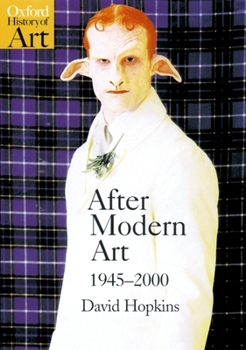After Modern Art, 1945-2000
Select Format
Select Condition 
Book Overview
Modern and contemporary art can be both baffling and beautiful; it can also be innovative, political, and disturbing. This book sets out to provide the first concise interpretation of the period as a whole, clarifying the artists and their works along the way. Closely informed by new critical approaches, it concentrates on the relationship between American and European art from the end of the Second World War to the eve of the new millennium. Jackson...
Format:Paperback
Language:English
ISBN:019284234X
ISBN13:9780192842343
Release Date:November 2000
Publisher:Oxford University Press, USA
Length:288 Pages
Weight:1.53 lbs.
Dimensions:0.7" x 9.0" x 6.3"
Customer Reviews
6 ratings
Something Missing
Published by Tabi , 11 months ago
I am satisfied with this book's content. I am a bit disappointed because someone had cut out several images throughout the book leaving me with gaps in the readings and half destroyed pages.
a good launching point into contemporary art
Published by Thriftbooks.com User , 16 years ago
After Modern Art gives the reader an overview of post war modern art. I found the author's references to more in depth material useful especially since some of it, including Greenberg's essays, are available on the web. The author mostly considers artists from America and Europe, but toward the end there is some mention of Russian artists who the west became aware of after the fall of the Berlin Wall. I wish the author had included more in depth material on the ideas behind the art he presented but I guess this would have made the book too large. This is a book that will make you want to read some of the books and essays that were pivotal to the artists. Many people find modern/contemporary art difficult to phantom. I think this is because much modern and contemporary art is a reaction to what came before. For instance, without knowing the masculine aspect of the Action Painting period one might not get the reference to genitals in the upper part of Jasper John's flag paintings. Also, with knowing that the bull was important to Picasso, one might not get why Andy Warhol used bull images in one of his wall paper type paintings. This book can help dispel that confusion as it neatly links each successive period in art to what came before.
Good book !
Published by Thriftbooks.com User , 23 years ago
i really enjoy reading the Oxford History of Art books. all of them are very informative and easy to read. i go to art school and these are the books are what we use as text books, so i highly recomend it !
Ripon College Art 370 reviews
Published by Thriftbooks.com User , 23 years ago
Here are some responses of undergrads at a liberal arts college in a seminar on contemporary art-Student 1:1. The book was interesting and well developed...it moved at a steady paceand was consistent.2. Hopkins used too many difficult words that weren't familiar and he wasunclear as to the main objective in some of his chapters.3. In some areas of the book, Hopkins only touched on some of the artistswho seemed important and went too into depth on a few others. He needed tokeep that aspect of the book consistent...the rest was well done.Student 2:Hopkins used many examples of Contemporary Art that were very relative to the concepts he explained. While they helped me to understand his ideas, some of his writing was very difficult to understand. He was wordy and used many uncommon terms making reading slow and hard to comprehend. This would be an excellent book for those who are in the advanced stages of learning about Contemporary Art. Student 3:Hopkins does a wonderful job of providing ample examples for the reader.However, he does not do a very good job of explaining the examples withoutcreating some confusion. Hopkin's also uses a vocabulary that is tooadvanced for the undergraduate reader that this book is intended for.Student 4:Hopkins used some very interesting examples to try and create a new way of looking at the transition from modern to post-modern art. I think that the book is mislabled as a beginner book, since from the start the author assumes that we have a strong basic knowledge of art history. To be fair the issue he is talking about in this book is so complex that writing an introduction is a very difficult task, I think that Hopkins did a good job.Student 5:-The book takes a different view on 20th century art, and helps put thingsin a historic context.-The book is difficult to understand at times, and seems to be at a higherthan introductory level.-Some of the references to works are vague, and they are hard to connect tothe photos.
The best overview of contemporary art
Published by Thriftbooks.com User , 23 years ago
I have - for professional reasons - read several introductions to contemporary art written in the late 90s, and this is by far the best. Hopkins does not only have a great knowledge on the field but he is also good at writing about it, and furthermore he is up to date with the latest scholary researches on the field without being academic in his way of formulating it.I recommend this for students and scholars as well as for the just interested. No matter who you are, you will definitely know much more about contemporary art than before, and have a lot of good color reproductions of the works as well.
Lightweight Champion
Published by Thriftbooks.com User , 23 years ago
This is a strong, broadly inclusive introduction to modern art disguised as a "regular"-looking paperback. The book is refreshingly un-dogmatic, and though there is evidence of the author's pomo leanings, he is not earnest about it. His prose is consistently smooth, nearly melodic in places. With its chronological and balanced approach, this is a palatable, but spicy, beginner's text.






